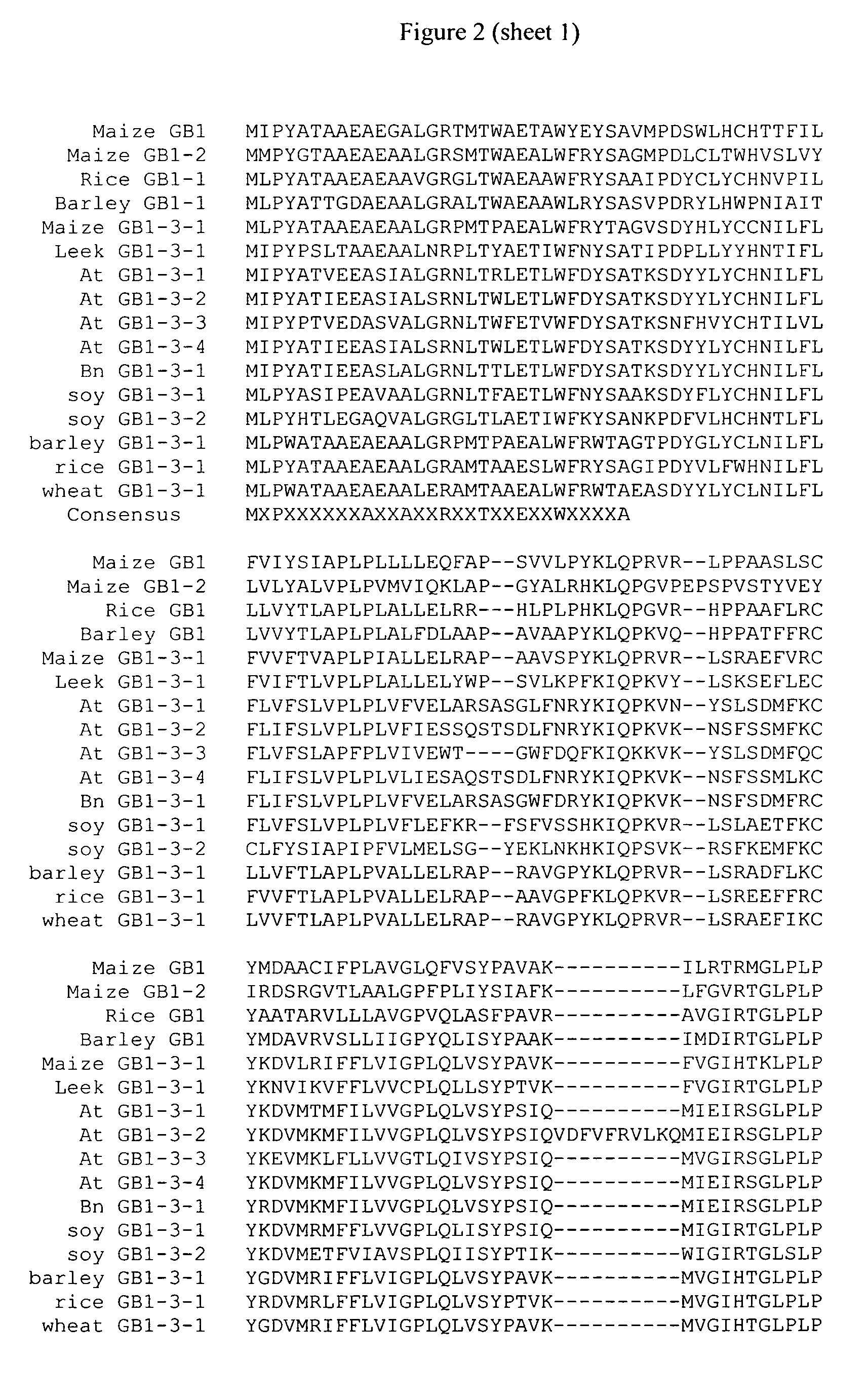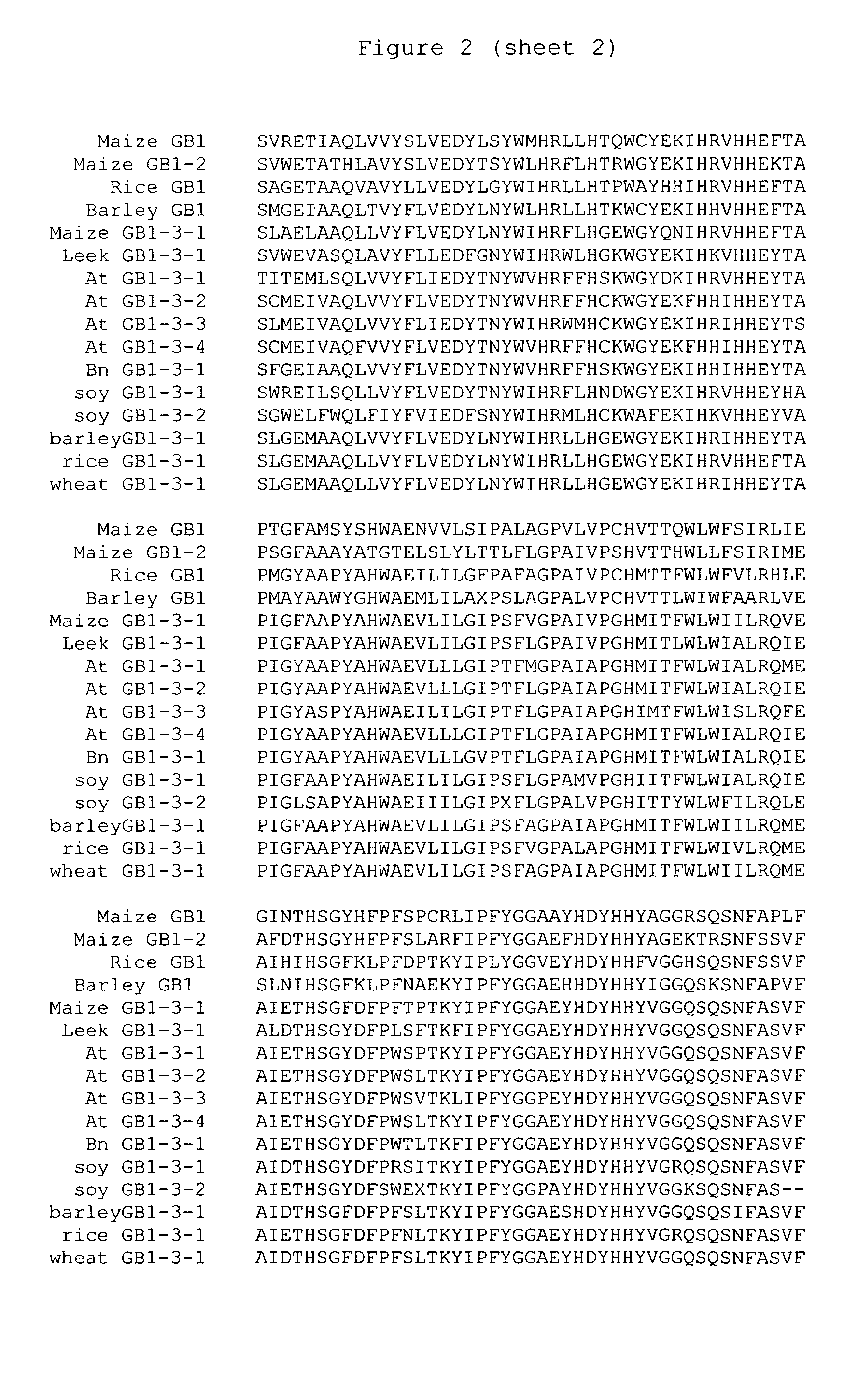Transgenic plants with increased glycine-betaine
a technology of glycine-betaine and transgenic plants, which is applied in the field of polynucleotide sequences, can solve the problems of reduced yield, increased susceptibility to disease and pests, and reduced plant performance, and achieves enhanced glycine-betaine levels, increased glycine-betaine content of transgenic plants, and improved tolerance to water-deficit, cold or freezing growing conditions
- Summary
- Abstract
- Description
- Claims
- Application Information
AI Technical Summary
Benefits of technology
Problems solved by technology
Method used
Image
Examples
example 1
[0122]Identification of a gb1 Gene from Zea mays
[0123]Plants from a number of non-transgenic inbred lines of Zea mays were field-grown under water-deficit (non-irrigated) or non-water-deficit (irrigated) conditions. Leaf samples were taken from plants before the tassel stage for each condition, and RNA and metabolites were isolated. RNA from the water-deficit and non-water-deficit samples was analyzed for differences using transcriptional profiling array methods. A number of RNAs were found to show differences in accumulation, to either higher or lower levels in the plants, depending upon the water treatment.
[0124]In addition to RNA transcription profiling, the glycine-betaine (GB) content was determined in leaf tissue samples from the inbred lines grown under water-deficit and non-water-deficit conditions. The characterized inbred maize lines were grouped into two categories: “GB accumulators,” comprising greater than about 0.05 mM GB, and “GB non-accumulators,” comprising less th...
example 2
[0128]Over-Expression of Exogenous DNA Constructs Comprising gb1 Coding Sequence in Transgenic Zea mays
[0129]Transgenic Zea mays of a GB non-accumulator line was prepared with an exogenous DNA comprising a constitutive promoter region comprising a rice actin 1 promoter and a rice actin 1 intron operably linked to the gb1 coding sequence of SEQ ID NO:19 encoding the GB1 polynucleotide of SEQ ID NO:1 (see pMON78450 in FIG. 3 and SEQ ID NO:57). Ro transgenic plants comprising low copy number events (that is, about 1-2 copies based upon molecular analysis) were selected for study. Transgenic non-accumulator plants comprising the gb1 exogenous DNA and non-transgenic control plants of both a GB non-accumulator line and a GB accumulator line were grown under greenhouse conditions and leaf samples taken at approximately the V6-V8 stage. Leaf samples from a total of 45 different transgenic events were examined for GB accumulation. Leaf samples were lyophilized, ground to a fine powder and m...
example 3
[0133]Expression of Exogenous DNA Constructs Comprising gb1 Coding Sequence and Homologs in Transgenic Zea mays
[0134]In substantially the same manner as in Example 2, a variety of exogenous DNA constructs comprising a gb1 coding sequence are transformed into the GB non-accumulating maize line (LH59) and a GB accumulating maize line (FBLL MAB, U.S. patent application Publication 20040016030, incorporated herein by reference). The gb1-containing DNA constructs are substantially similar to the construct illustrated in FIG. 3 except for combinations of promoter and gb1 coding sequence as described Table 2 where the promoter identified by “promoter sequence” replaces the rice actin 1 promoter and the gb1 coding sequence identified by “gb1 DNA sequence” replaces the maize gb1 coding sequence. The rice actin 1 intron is retained or deleted or replaced with other introns in the various constructs.
[0135]
TABLE 2Coding sequence and promoter combinations forthe expression of gb1 coding sequenc...
PUM
| Property | Measurement | Unit |
|---|---|---|
| temperatures | aaaaa | aaaaa |
| temperatures | aaaaa | aaaaa |
| atmospheric pressure | aaaaa | aaaaa |
Abstract
Description
Claims
Application Information
 Login to View More
Login to View More - R&D
- Intellectual Property
- Life Sciences
- Materials
- Tech Scout
- Unparalleled Data Quality
- Higher Quality Content
- 60% Fewer Hallucinations
Browse by: Latest US Patents, China's latest patents, Technical Efficacy Thesaurus, Application Domain, Technology Topic, Popular Technical Reports.
© 2025 PatSnap. All rights reserved.Legal|Privacy policy|Modern Slavery Act Transparency Statement|Sitemap|About US| Contact US: help@patsnap.com



